What is a Cross Media Blog?
This is one. We thought the best way to demonstrate Cross Media Blogs would be to produce one that shows you exactly what Cross Media Blogging can do for you. So, whether you are reading, listening, or watching this on video, do enjoy and feel free to contact me paul@yourcontentwrite.com if you have any questions.
What Can Cross Media Blogging Mean to You?

Imagine yours was the only business that provided your product or service, thereby eliminating all competition, solving your ideal clients’ burning issues and giving them exactly what they want and desire.
NOT ONLY THAT…
You rank number 1 on Google AND people connect with you and TRUST you to such an extent that they WANT to purchase YOUR product or service every time they need it.
NOT ONLY THAT…
They actively recommend your business to other potential customers too. And those customers do the same.
I’m not going to be twee and do the old ‘What would that do to your standard of living?’ But I think we can agree that the closer you can get to that scenario the better, right?
How close can we bring you to that dream?
At Your Content Write, Like the eager little marketing researchers we are, we’ve been chipping away for years to find the answer to that very question, and we’ve developed something very exciting:
Cross Media Blogging is the revolutionary new product from Your Content Write. It combines the power of the most effective marketing methods available today, with expertise from key professionals to generate (for you) unparalleled levels of user engagement, customer reach, accessibility, and lead generation.
How does it do that? To explain we need to break down the six elements that make up Cross Media Blogging and give you the juicy stats as to why they work and what they can do for you:
-
Commercially embrace the digital age we are living in.

How much of your current marketing efforts are online?
According to Web acquisition:
“Internet usage continues to grow rapidly, with over 5.18 billion (64.6 percent of the global population) users worldwide in 2023. This number is expected to reach 5.5-6 billion by 2024.”
You can, of course, continue to rely heavily on paper advertising, outdoor and billboards. They still have their place, but they are often not cost effective, and you are relying on your key demographic taking the time to look up from their phones and notice the right billboard at the right time for them to feel strongly enough about your company to make a purchase.

Put yourself in the mind of your customer.
As a consumer, you have no prior relationship with the company being advertised and therefore very little reason to do business with them. Traditional outdoor advertising works best for well-known brands, ones you probably already have done business with (ones you have probably regularly seen online). Then the billboard or bus advertisement merely acts as a reminder.
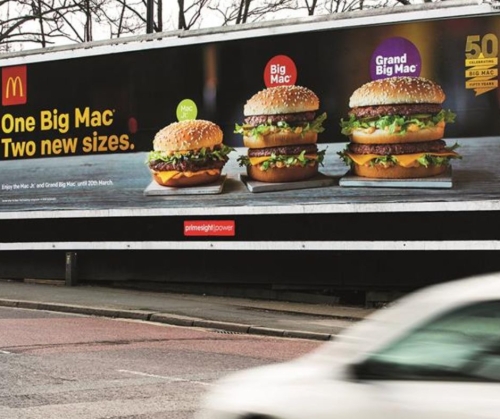
You could also advertise on the radio or the television. Having worked in both radio and television I can say that these are fantastic options if you have the money to get the job done properly and have your commercial aired at exactly the right times, then you will see results.
Since the invention of Netflix, Disney + and other streaming services however (as well as people’s preference for social media over television), these options tend to be regarded as overly expensive for reducing viewing figures.
According to Ofcom, the UK’s official communications regulators:
“Broadcast TV’s weekly reach fell from 83% in 2021 to 79% in 2022, the biggest-ever annual drop. The long-term decline in viewing of broadcast TV also continued – it fell by 12% year on year and was 16% lower than pre-pandemic levels.”

“For the first time, there is evidence of a significant decline in broadcast TV viewing among older audiences. Over-64s watched 8% less broadcast TV in 2022 than in 2021 and viewing was 6% lower than in 2019 (the last pre-pandemic year).”
“Older viewers are increasingly using streaming services, with take-up of Disney+ among online over-64s rising from 7% in 2022 to 12% in 2023.”
AND
“Among younger audiences, broadcast TV viewing continued to decline rapidly, falling by 21% year on year among those aged 4-34.”
HOWEVER IN THE ONLINE WORLD…
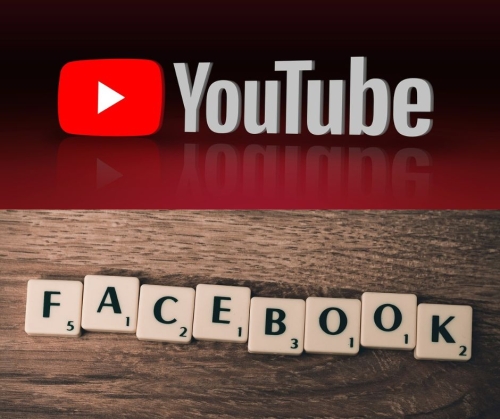
“YouTube and Facebook remain the largest social video platforms in the UK, each reaching 91% of UK internet users aged 15+ in Q1 2023.”
Okay, you’ve seen the stats. Can we agree your customers are online, and if you want to reach them then you need to be online too?
Excellent. So, the first essential ingredient to be placed into the ‘Cross Media Blogging’ mixing bowl is:
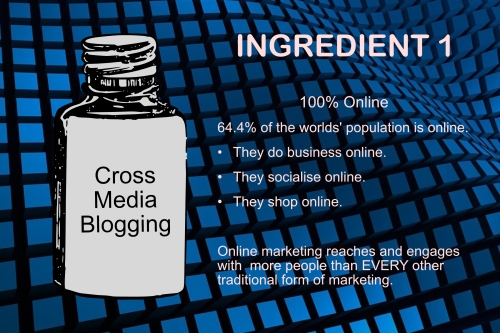
Your customers are online which means that’s exactly where you need to be.
- Your customers are habitual creatures, so they need to digest your content in a way that:
a. They are used to
b. Will incite trust
c. Has been PROVEN to positively impact your brand personality, leading to sales
As the more astute among you may have surmised, Cross Media Blogging has at its core a well-written and engaging blog.
The simple blog, when optimised and used ‘properly’ can make a tremendous difference to your marketing efforts. According to OptInMonster:
“Every month approximately 409 million people view more than 20 billion blog pages, leading to 77 million new blog comments from interested readers every month.”
IN FACT…
“77% of ALL internet users read blogs.”

According to Hubspot:
“Businesses that blog get 55% more website visitors than businesses that don’t.”
AND
“Marketers who prioritized blogging received 13X more ROI than companies that did not.”
And for those of you who are currently spending more on advertising to get new customers than blogging, HubSpot also found that:
“70% of people prefer to learn about a company through articles rather than advertisements.”
Why Blogging is so effective?
It’s all about building the right relationship with your customers.
In essence, the blog speaks the language of your customers, it reaches them directly and gives them the information that they want in an engaging and informative way… WITHOUT the pressure sale.
I could write an entire volume into the psychology of blogging and just why it has the power to transform your marketing efforts, but for now let’s go with the common-sense approach:

YOU are approached by someone in the street that you have never met, and they try to sell you something. What is your response?
The majority of people would probably not respond favourably and would either ignore, politely decline, or rather more directly tell this presumptuous stranger where to go.
What this person is selling might be of great value and just what you need, but as you have no history with the vendor or what it is that he/she/other is selling you have ZERO reason to trust them.
Your blog, however, is written to appeal ONLY to your ideal customer and give them the information that they want for FREE, and subsequent regular posts continue to do this. When this happens, potential customers get to know you, begin to trust you, and see you as the ‘expert’ in that field.

It doesn’t take a rocket scientist to work out who they will be spending their money with when they need to make that all-important purchase.
Blogs Written by Humans for Humans

In this age of AI-assisted writing it can be very tempting to subscribe to an online, artificial copywriting service and have your web copy done in seconds, and many people are doing just that. Unfortunately, this can actually hinder your marketing efforts for the following reasons:
a. Google (assuming you’d like your customers to find your website on Google) only embraces AI to a point and that point comes when people simply use it to churn out copy and then publish it.
Google has already stated that they will not rank AI content if:
“If you see AI as an inexpensive, easy way to game search engine rankings.”
“When it comes to automatically generated content, our guidance has been consistent for years. Using automation—including AI—to generate content with the primary purpose of manipulating ranking in search results is a violation of our spam policies.”
b. As a copywriter with over 20 years of experience under my belt, I can spot AI copy a mile off. It all feels very generic and merges in with the content that EVERY OTHER person out there using AI is producing. As such, human-generated content has the ability to stand out now more than ever.
“A company using well-written and researched human content will rank better on Google and will effectively shine like a beacon against the backdrop of those companies electing to promote their business just using AI-generated content.”
c. References and facts generated by AI are not always correct.
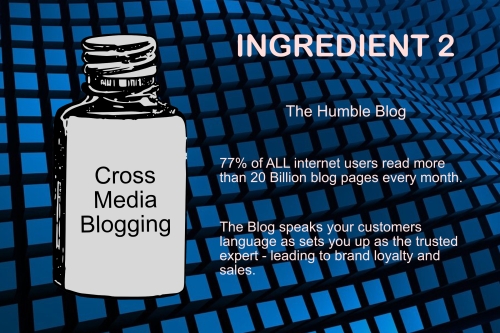
Needless to say then, the next element in our cross-media blog mixing bowl is the well-researched and engaging, ‘human-written’ blog post.
-
You need to be accessible to capture a wider audience.

If you want your company to be exclusive, then you NEED to be inclusive:
“One in every five people in the UK has a disability, one in ten has Dyslexia and approximately three hundred and sixty thousand are blind or visually impaired (a number set to rise to two point two five million in 2025).”
https://yourcontentwrite.com/crossmediablogs/
Think of the above in terms of spending power, then ask yourself: How are you currently reaching those demographics?
Add to this, that different people have different learning styles and take in and retain information in different ways. According to Avado Learning, a top-ranking platform:
“…roughly 65 percent of the population are visual learners, 30 percent are auditory learners.”
That’s roughly 26.4 million people in the UK who prefer to take in spoken information rather than have it written down.
The Professional Voice over Artist and the Cross Media Blog
There is a difference between a professional voice-over artist reading text and say, a business owner who is not a professional voice-over artist. Tonal quality, vocal inflexions, speed, and timing are all perfectly crafted over the years to produce something that will be instantly engaging and attractive to your potential customers.

For EVERY Cross Media Blog post we produce for you, there will be an audio version of that post that can be streamed directly from your site – boosting your Google ranking AND catering for those among your customers who can’t – or are too busy to – sit and read your content. We have a range of voice-over artists ready to give your brand the trusted voice and personality it deserves.
Add to this, our resident musician/producer further enhances your audio production with custom music and sound effects, giving your customers a truly unique and memorable experience.
So, the third element in the Cross Media Blog is the professional audio version that your customers can play directly from your blog post.

-
The power of the podcast
 Once your audio is recorded, we also turn it into a regular podcast show, opening up your potential audience again by nearly 5 million worldwide.
Once your audio is recorded, we also turn it into a regular podcast show, opening up your potential audience again by nearly 5 million worldwide.
According to podknowspodcasting:
“Podcasts are experiencing a surge in popularity around the world, with 61% of people, globally, reporting that they now listen to them.“
The same article also stated that the gender of podcast listeners was fairly evenly matched with 58% male and 42% female.
68% tend to listen to the entire episode too. This means that when your Cross Media Blog content is produced you have an audience the size of which is, frankly, unparalleled.
I’m sure also that many of my readers, listeners, and watchers (delete as appropriate) will already know that when you find a business podcast that really appeals to you, then you subscribe which means you are automatically notified every time a new episode is released.
You subscribe because you find the information both informative and perhaps entertaining too. You trust the information that is being given, as its purpose is to help without a pressure sales message – aside from a call to action contained within the podcast which might direct them toward a website / e-commerce platform or an email list – where you can actually engage them in a sales conversation.
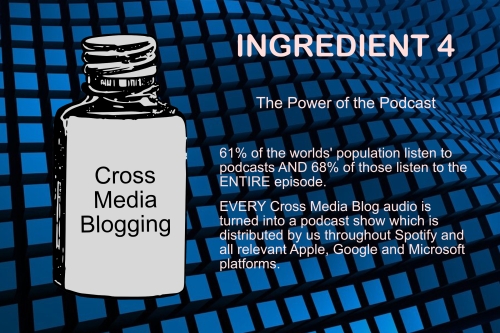
So, the fourth element in your Cross Media Blog is a high-quality podcast that is distributed by us, throughout Apple, Microsoft, Spotify, and relevant Google platforms.
-
Google and search engine ranking (SEO)

Ranking high on Google (and other search engines) can be critical to your business success.
According to Berkley the top eight benefits of ranking high on Google are:
Google Ranking Benefit 1: Brings Organic Search Traffic to your Website.
Google Ranking Benefit 2: Generates Leads Cost-Effectively.
Google Ranking Benefit 3: Increases Brand Awareness.
Google Ranking Benefit 4: Gets You Ahead of the Competition.
Google Ranking Benefit 5: Optimises Your Website for Mobile Users.
Google Ranking Benefit 6: Builds Trust.
Let’s Talk Numbers…
Type your business service or product into Google and see how many results come up. Now, take into account that position 1 receives an average of 31.7% of those clicks, position 2 – 24.71 and position 3 – 18.59%. By the time you get to the very top of page two, you are looking at an average of ONLY 0.63% clickthrough rate.
This leads to the oft-quoted SEO joke that if you want to hide a dead body, so it won’t be discovered, the best place is page two of Google.
Thank you to numeroagency and orbelo for those Google stats.
To make sure your website is seen by as many people as possible, we have enlisted the help of a top-notch SEO consultant – or Google specialist, if you like – to help rise your Cross-Media Blog (and therefore your business website) to the top of Google.
Voice Engine Optimisation

A little speculation here, but we are also working hard to make your branded audio playable on Alexa and Siri as a result of a relevant user query. Early days and a little more experimentation are needed for this one, but as soon as it’s ready our Cross Media Blog clients’ content will automatically benefit from this.
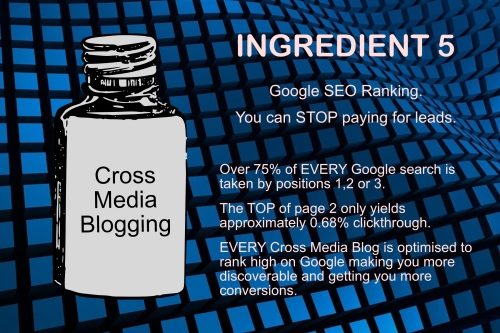
So, the fifth element to be added to your Cross Media Blog is a dedicated SEO consultant to optimise your audio, written and video content so it will rank high on Google and the other search engines.
-
Your business on Video.

As an added extra, we can also include video production to your Cross Media Blog.
Whilst television may be experiencing dwindling viewing figures (as mentioned above) high-quality video content is NOT. According to Dash:
“In 2023 people are watching, on average, 17 hours of online video per week.”
Videos are also: “twice as likely to be shared than any other form of content.”
YouTube alone, has over two billion monthly users and 70% of viewers made a purchase as a result of seeing a brand on YouTube. This is probably part of the reason why 87% of marketers attribute sales back to their online video marketing efforts.
Your Content Write has teamed up with a long-established video production company to take your Cross Media Blog audio and add some stunning visuals/animation, which will then be uploaded to YouTube and optimised to rank on Google, as well as cutting a few short samples from your video content to be shared throughout your social media channels.
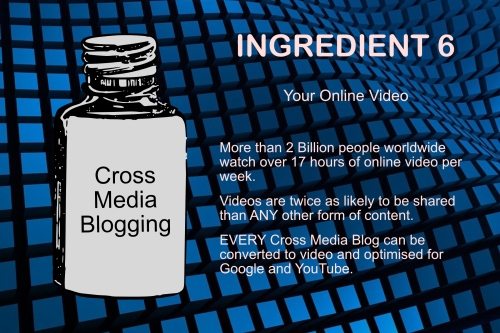
So, the sixth optional element we can add to our Cross Media Blog mixing bowl is the video content created edited and uploaded to YouTube.
So, what is Cross Media Blogging?
Cross Media blogging is the coming together of traditional blogging, audio marketing, podcasting, SEO Google optimisation and video marketing to create a product that can take you to the top of Google and gain the loyalty, trust and… money of more customers than you have ever experienced (see above for relevant stats).
And you don’t even need to come up with content ideas. Our researchers already know what is trending and what YOUR customers WANT to know about. We also look at gaps in your competitors’ content marketing strategy meaning you will absolutely stand out from the competition.
Ready to Stand Apart from Your Competition?
Click the link below and book a call and you can find out how Cross Media Blogging can take your business to the next level.
https://meetings-eu1.hubspot.com/greystoke
You can also SUBSCRIBE to our Cross Media Blog podcast, HERE:






